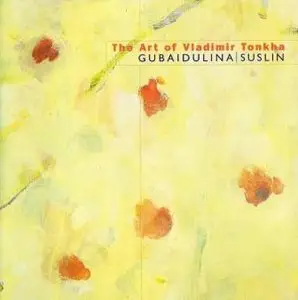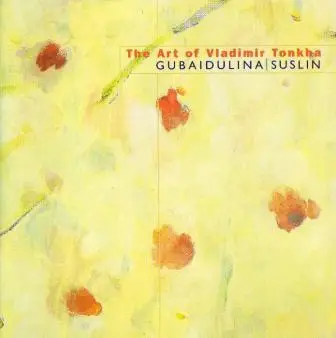Gubaidulina & Suslin - Chanson Contre Raison, Madrigal, Quaternion, 10 Preludes (repost)
Classical | EAC: FLAC+Cue+Log | 1 Cd, Covers + Booklet | 217 Mb
Label: Megadisc - Date: 2001
Classical | EAC: FLAC+Cue+Log | 1 Cd, Covers + Booklet | 217 Mb
Label: Megadisc - Date: 2001
“Chanson contre raison” (“Song against Reason”) Is the title of a French love song dating back to the days of Guillaume de Machaut. It appeared so symbolic to me that I could not resist the temptation of starting some rumours. However, this motto also entails commitment and rules out every possibility of ‘science-oriented’ rationality.Requested by 13mh13
This piece is in fact a kind of ‘Mephisto waltz’, marked by the appropriate compositional consequences. One of the purely instrumental aspects, too, is quite remarkable : two thirds of the oeuvre are played Scordatura (H1 instead of C). This fundamentally changes the disposition of the flageolet, the acoustics of the instrument and the timbre of the C-string. The return to normal (Scordatura H1 in C) during the performance occurs roughly where the golden section would be. The two episodes, the one in normal and the one in changed tune, compare more or less in the same way as dissonance and consonance; the changed acoustics of the instrument dissolve into the normal acoustics of the second episode. The piece is dedicated to Gunter Ribke, who was also the first to perform it in Lübeck on 5 October 1984. Viktor Suslin
Madrigal for two cellos [1998] This work was composed in February 1998 and was conceived as a personal birthday present for two exceptional musicians who are very dear to me : Hyung-Jung Sung and Julius Berger. Writing for two musicians of this calibre is very exciting. It is not every day that a composer succeeds in writing a musical piece that unites two people who were born to two completely different cultures and whose birthplaces are so far apart. In my work I attempt to vanquish purely musical dissimilarities, a process requiring the two halves of the duo to make their way toward each other until they finally meet. I do not want to expand too much on the subject : even the most sharp-witted comments are useless if one does not hear what is in the music. I would just like to say the following : the tuning plays a very important role in this composition, not only in the metaphorical sense of the word, but in the literal sense in particular.This means that the difference between “D sharp and “E flat” or, more precisely, between the natural micro-interval and the chromatic quartertone should be as clearly audible as possible. I hope that “Madrigal” will prove to be more than just a composition written for a special occasion. Madrigal differs somewhat from my usual work and I tried some new things with this composition. Viktor Suslin
Quaternion. This work was composed in 1996 and is dedicated to the Moscow cellist Vladimir Tonkha, founder of a uniquely professional quartet consisting of four cellists. The title “Quaternion” resembles the more customary designation “Quartet,” but there is a difference. By using this term I want to particularly emphasise the unity of the four-member ensemble, consisting as it does of four identical instruments. The instrument seems to be “one,” yet is divided into four as well. The term “quaternion” is a mathematical one. In the middle of the previous century, U. R. Hamilton used it to designate the “four-one” numbers consisting of one real and three “imaginary” components. In this way I could imagine a metaphor: on the one hand, the actual pitches played arco or pizzicato, on the other, various states of tonal indefiniteness (ricochet with the wood of the bow, playing with the fingers on the strings, playing with thimbles on the strings, different types of glissando and, finally, in the coda, playing with the bow on the fingerboard). The principal theme is the “drama” of tones expanding by quarter-tone steps. A dramatic development, as it were, arises in response to this expansion; this development peaks in the unification of all four instruments into one single sound (the bows playing on the fingerboards). The sound is not precisely definable. It is somehow present, and, at the same time, not really there. Sofia Gubaidulina
Ten Preludes for Violoncello Solo. In the early 1970s a professor at the Novosibirsk Conservatory requested that I compose cello etudes for a collection of tutorial pieces that he was to edit. This seemed like a very interesting task to me although I knew that what I composed would hardly be printed. So I wrote simply “for myself.” As expected, my work did not appeal to the professor, and so he did not take anything of what I had written into consideration for his collection. (Later on,my work was in fact published by “Sovietski Kompozitor” in Moscow - but the professor was no longer involved in this undertaking.) My work remained unnoticed for a long time until two first class Moscow cellists, Ivan Monighetti and Vladimir Tonkha, got hold of the score. Each musician played the composition not only perfectly, but also truly made it his “own” work in every sense of the word.The last prelude of the cycle (“Senza arco - senza pizzicato”) especially offers the performers the chance to make the work his or her “own.” Here, improvisatory sections break through the composed score; each player can interpret them in different ways. My express intention was to recognise how music’s content can change according to the instrumentalist’s creative imagination. Vladimir Tonkha, who gave the world premiere of these miniatures in December 1977, impressed listeners with his truly ingenious imagination. Thus the music gained an absolutely unexpected significance for me as well as a special metaphysical meaning. That is why the ending of this piece belongs entirely to him. I interpret the word “etude” to mean an artistic sketch, and, in the present case, sketches of various methods of sound formation. After much discussion, Vladimir Tonkha and I reached the conclusion that the work should not be called “Etudes,” but rather “Preludes” for violoncello solo, since the term “Etudes” only partially applied to the work’s content. Since Vladimir Tonkha was not only the “godfather” of the Preludes but also the editor of the printed edition, this work has been dedicated to him. Sofia Gubaidulina
Tracks:
01. Suslin: Chanson contre raison [0:10:59.00]
02. Suslin: Madrigal [0:10:19.25]
03. Gubaidulina: Quaternion [0:23:02.25]
04. Gubaidulina: 10 Preludes - 1. Staccato - legato [0:01:30.50]
05. 2. Legato - staccato [0:02:11.50]
06. 3. Con sordino - senza sordino [0:02:17.50]
07. 4. Ricochet [0:01:25.17]
08. 5. Sul pontecello - ordinario - sul tasto [0:03:12.58]
09. 6. Flagioletti [0:02:04.67]
10. 7. Al taco - da punta d’arco [0:01:21.33]
11. 8. Arco - pizzicato [0:01:29.25]
12. 9. Pizzicato - arco [0:01:41.00]
13. 10. Senza arco, senza pizzicato [0:02:13.43]
Exact Audio Copy V1.0 beta 3 from 29. August 2011
EAC extraction logfile from 26. February 2013, 0:07
Gubaidulina & Suslin / Chanson Contre Raison, Madrigal, Quaternion, 10 Preludes
Used drive : TSSTcorpCDDVDW SH-S223C Adapter: 2 ID: 1
Read mode : Secure
Utilize accurate stream : Yes
Defeat audio cache : Yes
Make use of C2 pointers : No
Read offset correction : 697
Overread into Lead-In and Lead-Out : No
Fill up missing offset samples with silence : Yes
Delete leading and trailing silent blocks : No
Null samples used in CRC calculations : Yes
Used interface : Native Win32 interface for Win NT & 2000
Used output format : User Defined Encoder
Selected bitrate : 896 kBit/s
Quality : High
Add ID3 tag : No
Command line compressor : C:\Program Files (x86)\Exact Audio Copy\FLAC\FLAC.EXE
Additional command line options : -V -0 -T "COMMENT=Ripped by Tapaz9" -T "artist=%artist%" -T "title=%title%" -T "album=%albumtitle%" -T "date=%year%" -T "tracknumber=%tracknr%" -T "genre=%genre%" %source%
TOC of the extracted CD
Track | Start | Length | Start sector | End sector
––––––––––––––––––––––––––––-
1 | 0:00.00 | 10:59.00 | 0 | 49424
2 | 10:59.00 | 10:19.25 | 49425 | 95874
3 | 21:18.25 | 23:02.25 | 95875 | 199549
4 | 44:20.50 | 1:30.50 | 199550 | 206349
5 | 45:51.25 | 2:11.50 | 206350 | 216224
6 | 48:03.00 | 2:17.50 | 216225 | 226549
7 | 50:20.50 | 1:25.17 | 226550 | 232941
8 | 51:45.67 | 3:12.58 | 232942 | 247399
9 | 54:58.50 | 2:04.67 | 247400 | 256766
10 | 57:03.42 | 1:21.33 | 256767 | 262874
11 | 58:25.00 | 1:29.25 | 262875 | 269574
12 | 59:54.25 | 1:41.00 | 269575 | 277149
13 | 61:35.25 | 2:13.43 | 277150 | 287167
Range status and errors
Selected range
Filename F:\Musique\Gubaidulina, Sofia\GubaidulinaAndSuslin\Gubaidulina & Suslin - Chanson Contre Raison, Madrigal, Quaternion, 10 Preludes.wav
Peak level 95.8 %
Extraction speed 12.9 X
Range quality 100.0 %
Copy CRC 09293C69
Copy OK
No errors occurred
End of status report
==== Log checksum 5DF143A98C2D48FAC4C3ED73027FA033852904D80638B662B2F9A5D36DA5804E ====
No Mirrors and Torrent-uploads Please
See my classical digital download posts in the Vinyl & HR section or check out My Avax blog
See my classical digital download posts in the Vinyl & HR section or check out My Avax blog



